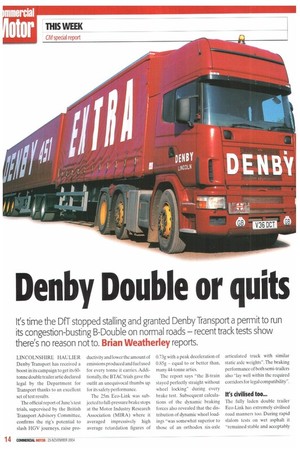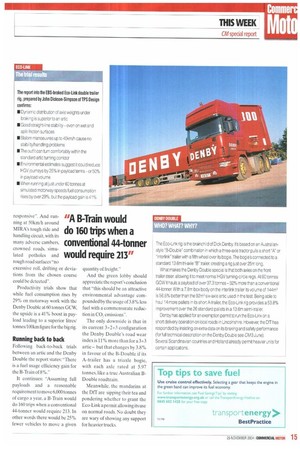Denby Double or quits
Page 14

Page 15

If you've noticed an error in this article please click here to report it so we can fix it.
It's time the NT stopped stalling and granted Denby Transport a permit to run its congestion-busting B-Double on normal roads — recent track tests show there's no reason not to. Brian Weatherley reports.
LINCOLNSHIRE HAULIER Denby Transport has received a boost in its campaign to get its 60tonne double trailer artic declared legal by the Department for Transport thanks to an excellent set of test results.
The official report of June's test trials, supervised by the British Transport Advisory Committee, confirms the rig's potential to slash HGV journeys, raise pro ductivity and lower the amount of emissions produced and fuel used for every tonne it carries. Additionally, the BTAC trials gave the outfit an unequivocal thumbs up for its safety performance.
The 25m Eco-Link was subjected to full-pressure brake stops at the Motor Industry Research Association (MIRA) where it averaged impressively high average retardation figures of 0.73g with a peak deceleration of 0.85g — equal to or better than, many 44-tonne artics.
The report says "the B-train stayed perfectly straight without wheel locking" during every brake test. Subsequent calculations of the dynamic braking forces also revealed that the distribution of dynamic wheel loadings -was somewhat superior to those of an orthodox six-axle articulated truck with similar static axle weights". The braking performance of both semi-trailers also "lay well within the required corridors for legal compatibility".
It's civilised too...
The fully laden double trailer Eco-Link has extremely civilised road manners too. During rapid slalom tests on wet asphalt it "remained stable and acceptably responsive". And running at 50km/h around MIRA's tough ride and handling circuit, with its many adverse cambers, crowned roads, simulated potholes and rough road surfaces "no excessive roll, drifting or deviations from the chosen course could be detected".
Productivity trials show that while fuel consumption rises by 29% on motorway work with the Denby Double at 60 tonnes GCW, the upside is a 41% boost in payload leading to a superior litres/ tonnes/100km figure for the big rig.
Running back to back
Following back-to-back trials between an artic and the Denby Double the report states: "There is a fuel usage efficiency gain for the B-Train of 8%."
It continues: "Assuming full payloads and a reasonable requirement to move 6,000 tonnes of cargo a year. a B-Train would do 160 trips when a conventional 44-tonner would require 213. In other words there would be 25% fewer vehicles to move a given quantity of freight."
And the green lobby should appreciate the report's conclusion that "this should be an attractive environmental advantage compounded by the usage of 3.8% less fuel with a commensurate reduction in CO, emissions-.
The only downside is that in its current 3+2+3 configuration the Denby Double's road wear index is 11% more than for a 3+3 artic— but that changes by 3.8% in favour of the B-Double if its A-trailer has a triaxle bogie with each axle rated at 5.97 tonnes, like a true Australian BDouble roadtrain.
Meanwhile, the mandarins at the DfT are sipping their tea and pondering whether to grant the Eco-Link a permit allowing its use on normal roads. No doubt they are wary of showing any support for heavier trucks.
























































































































































































